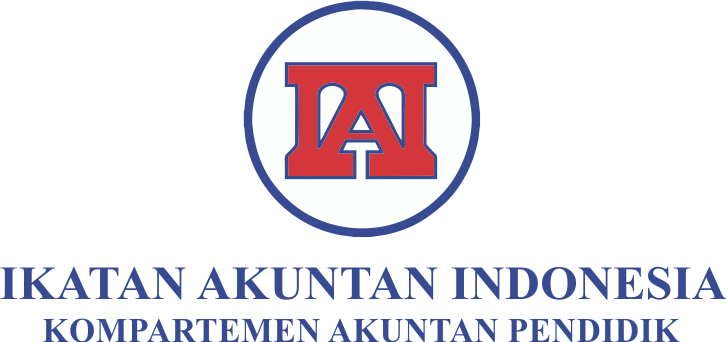Efektivitas Audit Intern dalam Pencegahan Fraud pada Pemerintahan Desa di Kabupaten Majalengka
Abstract
Keywords
Full Text:
PDF (Bahasa Indonesia)References
Ainia Salsabila, & Hepi Prayudiawan. (2011). Pengaruh Akuntabilitas, Pengetahuan Audit dan Gender Terhadap Kualitas Hasil Kerja Auditor Internal (Studi Empiris Pada Inspektorat Wilayah Provinsi DKI Jakarta). Jurnal Telaah Dan Riset Akuntansi, 4(2), 155–175.
Alqudah, H., Lutfi, A., abualoush, S. habis, Al Qudah, M. Z., Alshira’h, A. F., Almaiah, M. A., Alrawad, M., & tork, M. (2023). The impact of empowering internal auditors on the quality of electronic internal audits: A case of Jordanian listed services companies. International Journal of Information Management Data Insights, 3(2). https://doi.org/10.1016/j.jjimei.2023.100183
Alzeban, A., & Gwilliam, D. (2014). Factors affecting the internal audit effectiveness: A survey of the Saudi public sector. Journal of International Accounting, Auditing and Taxation, 23(2), 74–86. https://doi.org/10.1016/j.intaccaudtax.2014.06.001
Alzeban, A., & Sawan, N. (2015). The impact of audit committee characteristics on the implementation of internal audit recommendations. Journal of International Accounting, Auditing and Taxation, 24, 61–71. https://doi.org/10.1016/j.intaccaudtax.2015.02.005
Amiruddin. (2017). The Performance Of Government Auditors In Perspectives Ethical Behavior And Tendency Of Accounting Fraud. IOSR Journal of Economics and Finance, 8(4), 35–42. https://doi.org/10.9790/5933-0804043542
Atmadja, A. T., & Saputra, A. K. (2017). Pencegahan Fraud dalam Pengelolaan Keuangan Desa. Jurnal Ilmiah Akuntansi Dan Bisnis, 7. https://doi.org/10.24843/jiab.2017.v12.i01.p02
Bimo, S. (2017). Uji Mediasi dengan Sobel Test. Www.Statistikolahdata.Com. http://www.statistikolahdata.com/2017/01/uji-mediasi-dengan-sobel-test.html
Coram, P., Ferguson, C., & Moroney, R. (2008). Internal audit, alternative internal audit structures and the level of misappropriation of assets fraud. Accounting and Finance, 48(4), 543–559. https://doi.org/10.1111/j.1467-629X.2007.00247.x
Dewi, N. K. P. P., & Rasmini, N. K. (2019). Pengaruh Kompetensi SDM dan Locus Of Control Pada Pencegahan Fraud dalam Pengelolaan Dana Desa. E-Jurnal Akuntansi, 29(3), 1071. https://doi.org/10.24843/eja.2019.v29.i03.p12
Diansari, R. E., & Wijaya, A. T. (2019). Diamond fraud analysis in detecting financial statement fraud. Journal of Business and Information Systems (e-ISSN: 2685-2543), 1(2), 63–76. https://doi.org/10.36067/jbis.v1i2.23
Drogalas George, Karagiorgos Theofanis, & Arampatzis Konstantinos. (2015). Factors Associated with Internal Audit Effectiveness: Evidence from Greece. Journal of Accounting and Taxation, 7(7), 113–122.
Dwi Alvianti, E., Robert, M. H., & Pardede, P. P. (2019). PENGARUH INDEPENDENSI DAN KOMPETENSI AUDITOR INTERNAL TERHADAP EFEKTIVITAS SISTEM PENGENDALIAN INTERN PADA PERUM DAMRI CABANG SAMARINDA (Vol. 1, Issue 2). Oikonomia.
Fitria Nan Indria, M., Purnamasari, P., Gunawan, H., Akuntansi, P., & Ekonomi dan Bisnis, F. (2015). Pengaruh Independensi Auditor Internal dan Kesesuaian Kompensasi terhadap Pencegahan Kecurangan Aset. Prosiding Akuntansi, 360–367. www.merdeka.com
Free, C. (2015). Looking through the fraud triangle: A review and call for new directions. Meditari Accountancy Research, 23(2), 175–196. https://doi.org/10.1108/MEDAR-02-2015-0009
Ghozali, I. (2012). Aplikasi Analisis Multivariate dengan Program IBM SPSS. Universitas Diponegoro.
Hamdani, R., & Albar, A. R. (2016). Internal controls in fraud prevention effort: A case study. Jurnal Akuntansi & Auditing Indonesia, 20(2), 127–135. https://doi.org/10.20885/jaai.vol20.iss2.art5
Hilal, W., Gadsden, S. A., & Yawney, J. (2022). Financial Fraud: A Review of Anomaly Detection Techniques and Recent Advances. In Expert Systems with Applications (Vol. 193). Elsevier Ltd. https://doi.org/10.1016/j.eswa.2021.116429
Irma Indriani, Agus Surono, & Siti Maghfiroh. (2016). PENERAPAN KONSEP FRAUD DIAMOND THEORY DALAM MENDETEKSI PERILAKU FRAUD. Simposium Nasional Akuntansi XIX, Lampung.
Jack W. Dorminey, A. Scott Fleming, Mary-Jo Kranacher, & Richard A.
Riley. (2010). Beyond the fraud triangle: Enhancing deterrence of economic crimes. The CPA Journal, 17–23.
Jamil, M. M., Abidin, N. H. Z., & Alwi, N. M. (2022). The governance structure on the role of internal auditors in environmental auditing practices: Cases of Malaysian local organisations. Environmental Challenges, 9, 100632. https://doi.org/10.1016/j.envc.2022.100632
Juanim. (2004). Analisis Jalur dalam Riset Pemasaran Teknik Pengolahan Data SPSS & LISREL. Fakultas Ekonomi Universitas Pasundan Bandung.
Kasper, M., & Alm, J. (2022). Audits, audit effectiveness, and post-audit tax compliance. Journal of Economic Behavior and Organization, 195, 87–102. https://doi.org/10.1016/j.jebo.2022.01.003
Kline, R. B. (2011). Principles and Practice Equation Modeling. Guilford Press.
Lestari, Y. A., & Bernawati, Y. (2020a). Efektifitas Peran Internal Audit Dalam Mencegah Dan Mendeteksi Kecurangan. Jurnal Akuntansi Dan Pajak, 20(2). https://doi.org/10.29040/jap.v20i2.740
Lestari, Y. A., & Bernawati, Y. (2020b). Efektifitas Peran Internal Audit Dalam Mencegah Dan Mendeteksi Kecurangan. Jurnal Akuntansi Dan Pajak, 20(2). https://doi.org/10.29040/jap.v20i2.740
Li, J., Li, N., Xia, T., & Guo, J. (2023). Textual analysis and detection of financial fraud: Evidence from Chinese manufacturing firms. Economic Modelling, 106428. https://doi.org/10.1016/j.econmod.2023.106428
(Lucan), A. N. C., Hlaciuc, E., & Zaiceanu, A. M. (2015). The Impact and Results of the Internal Audit Activity Exercised in the Public Sector in Romania. Procedia Economics and Finance, 32, 394–399. https://doi.org/10.1016/s2212-5671(15)01409-4
Manossoh, H. (2016). FAKTOR-FAKTOR PENYEBAB TERJADINYA FRAUD PADA PEMERINTAH DI PROVINSI SULAWESI UTARA. Jurnal EMBA, 4(1), 484–495.
Mihret, D. G., & Yismaw, A. W. (2007). Internal audit effectiveness: An Ethiopian public sector case study. Managerial Auditing Journal, 22(5), 470–484. https://doi.org/10.1108/02686900710750757
Muhammad Basirruddin. (2014). Peran Pemerintahan Desa dalam Pengelolaan Keuangan Desa Alai Kecamatan Tebing Tinggi Barat Kabupaten Kepulauan Meranti Tahun 2012. Jom FISIP, 1(2).
Mulyadi. (2016). Sistem Akuntansi (4th ed.). Salemba Empat.
Nainggolan, C. S., Jatmiko, T., & Prabowo, W. (2019). ANALISIS DETERMINAN AUDITOR INTERNAL PADA EFEKTIVITAS AUDIT INTERNAL SEKTOR PUBLIK (STUDI PADA INSPEKTORAT PROVINSI DKI JAKARTA). DIPONEGORO JOURNAL OF ACCOUNTING, 8(4), 1–13. http://ejournal-s1.undip.ac.id/index.php/accounting
Nurul Aini, Made Aristia Prayudi, & I Putu Gede Diatmika. (2017). PENGARUH PERSEPEKTIF FRAUD DIAMOND TERHADAP KECENDERUNGAN TERJADINYA KECURANGAN (FRAUD) DALAM PENGELOLAAN KEUANGAN DESA. JIMAT (JURNAL ILMIAH MAHASISWA AKUNTANSI) UNDIKSHA, 8(2).
Priyono. (2008). Metode Penelitian Kuantitatif. Zifatama Publishing.
Sekaran, U. (2006). Metodologi Penelitian untuk Bisnis. Badan Penerbit Universitas Diponegoro.
Sudjarweni, V. W. (2015). Metodologi Penelitian Bisnis dan Ekonomi. Pustaka Baru Press.
Sugiarto. (2001). Teknik Sampling. PT. Gramedia Pustaka Utama.
Sugiyono. (2013). Metode Penelitian Kuantitatif, Kualitatif dan R&D. Alfabeta.
Sugiyono. (2015). Metode Penelitian Manajemen. Alfabeta.
Sunyoto, D. (2016). Metodologi Penelitian Akuntansi. Reflika Adimata.
Sutaryo, S. (2018). DETERMINAN EFEKTIVITAS AUDIT INTERNAL DI INSPEKTORAT PROVINSI JAWA TIMUR. Jurnal Ilmiah Akuntansi Dan Bisnis, 1. https://doi.org/10.24843/JIAB.2018.v13.i01.p01
DOI: https://doi.org/10.37058/jak.v19i1.9877
Refbacks
- There are currently no refbacks.
Copyright (c) 2024 JURNAL AKUNTANSI

This work is licensed under a Creative Commons Attribution-NonCommercial-ShareAlike 4.0 International License.

Jurnal Akuntansi by Jurusan Akuntansi Fakultas Ekonomi dan Bisnis Universitas Siliwangi is licensed under a Creative Commons Attribution-NonCommercial-ShareAlike 4.0 International License.
Based on a work at http://jurnal.unsil.ac.id/index.php/jak.
Jurnal Akuntansi Visitor Counter JAK Stats






